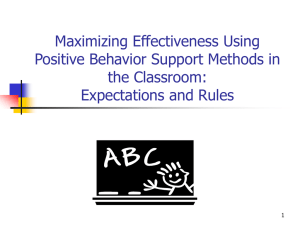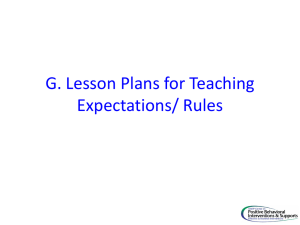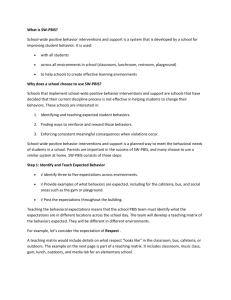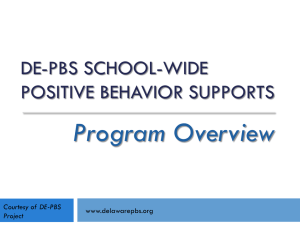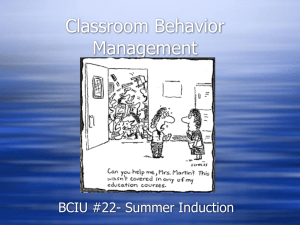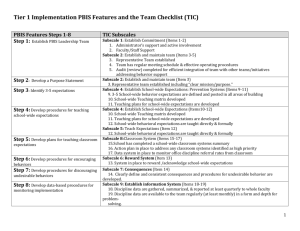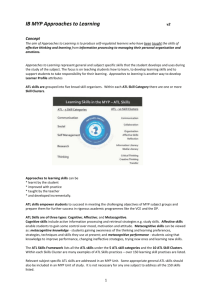ATL/PBIS - Student Services
advertisement
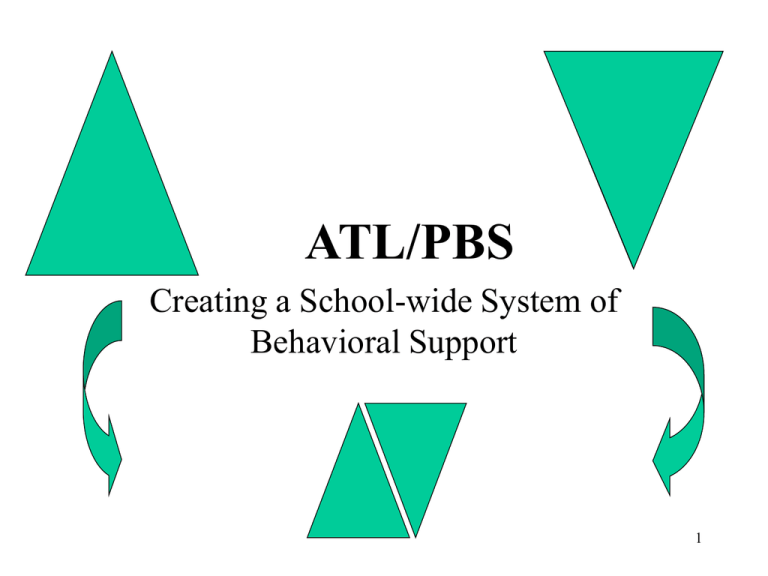
ATL/PBS Creating a School-wide System of Behavioral Support 1 Agenda Welcome and History MMSD Guiding Principles Current Practices PBIS Overview/theory/components Break 9:40 am Common Expectations: Matrix Work Lunch 11:30 am Acknowledgments and Celebrations Break 1:30 pm Inappropriate Behaviors Below/Bottom Line Kick off and Sustainability Sharing Out and Closing 2 MMSD Guiding Principles Team Time • What resonates with you? • How does this document fit with beliefs in your building? 3 Why a positive approach to discipline? • Most common responses to at risk students are punishment and exclusion (Lipsey, 1991; Tolan & Guerra, 1994) • Punishment, counseling and psychotherapy are the least effective responses to reduce antisocial and violent behavior in group settings (Gottfredson, 1997; Kazdin, 1985; Lipsey, 1991, 1992; Lipsey & Wilson, 1993; Tolan & Guerra, 1994) • Punishing behaviors without a universal system of support is associated with increased occurrences of aggression, vandalism, truancy, tardiness and dropping out (Mayer and Sulzer-Azaroff (1991) 4 What does a system need to include? • Body of evidence that enables us to identify strategies that are effective in preventing and reducing problem behavior (Biglan, 1995; Gottfredson, 1997; Colvin, et al., 1993; Lipsey, 1991, 1992; Mayer, 1995; Sugai & Horner, 1994; Tolan & Guerra, 1994; Walker, et al., 1995; Walker, et al., 1996) – – – – – Community building Safe skills Social Skills instruction Positive recognitions and celebrations Teaching procedures and routines 5 Team time Current practices Who is responsible Needs Community Social Skills Safe Skills Positive celebrations and recognitions Teaching procedures and routines 6 One Thought Intelligence plus character. That is the goal of true education.” “ Martin Luther King Jr. 7 What PBIS is… • A process that emphasizes the creation of systems that support the adoption and durable implementation of evidence-based practices and procedures. • An interactive approach that includes opportunities to correct and improve four key elements used in Universal PBS focusing on: 8 Supporting Social and Academic Competence & Behavioral Development 4 PBS Elements OUTCOMES Supporting Decision Making Supporting Staff Behavior PRACTICES Supporting Child Behavior 9 What PBIS is not… • A “Train and Hope” model • A “Get Tough” model • Not limited to any particular group of children – it’s for all children • Not a specific practice or curriculum…it’s a general approach to preventing problem behavior • Not new…its based on a long history of behavioral practices &effective instructional design & strategies 10 Who should use PBIS? Schools that want to: • Improve general activity & school climate & community relations • Decrease dependence on reactive disciplinary practices • Maximize impact of instruction to affect skill development and behavioral competency • Improve behavioral supports for students with emotional & behavioral challenges 11 The Big “BIG” Ideas 1. Decide what is important for youth to know 2. Teach what is important for youth to know 3. Keep track of how youth are doing 4. Make changes according to the results 12 “Positive Behavior Supports Biggest Idea!” Instead of working harder, schools have to establish systems/processes and use data and practices that enable them to work smarter. PBS Enables Schools To… – Establish a small number of priorities • ABOVE THE LINE strategies • “do less, better” – Consolidate/integrate whenever possible • “only do it once” – Specify what is wanted & how you’ll know when you get there • “invest in a clear outcome and assess progress” – Give priority to what works • “invest in a sure thing” 13 CONTINUUM OF SCHOOL-WIDE INSTRUCTIONAL & POSITIVE BEHAVIOR SUPPORT ~5% ~15% Tertiary Prevention: Specialized Individualized Systems for Students with High-Risk Behavior Secondary Prevention: Specialized Group Systems for Students with At-Risk Behavior Primary Prevention: “Above the Line” School-/ClassroomWide Systems for All Students, Staff, & Settings ~80% of Students 14 PBS Emphasizes Instruction and Prevention at Each Tier • Universal Tier “Above the Line” GOAL: To increase social learning and reduce new cases of problem behavior • Secondary Tier GOAL: provide targeted interventions with a continued focus on asset development and skillbuilding. • Tertiary Tier GOAL: reduce the intensity and complexity of existing occurrences of severe problem behaviors15 School-wide Practices of ATL/PBS Define *3-5 School-wide Above the Line Expectations Teach /Precorrect *Direct Instruction of expectations Teaching Matrix, Cool Tools *In the moment reminders Boosters, pre-corrections Model/ adults practice what we preach Practice/ kids practice what we teach Acknowledge *Daily recognition social, tangible *Weekly/quarterly grade-level/whole school celebrations Reteach *Classroom procedure for minor problem behaviors * Discipline Referral for major problem behaviors 16 What does ATL/PBS look like? • >80% of students can tell you what is expected of them & give behavioral examples because they have been taught, actively supervised, practiced, & acknowledged. • Positive adult-to-student interactions exceed negative • Function based behavior support is foundation for addressing problem behavior. • Data- & team-based action planning & implementation are operating. • Administrators are active participants. • Full continuum of behavior support is available to all students 17 Supporting Social Competence & Academic Achievement School Wide Supporting Staff Learning and Behavior SCHOOLWIDE/CLASSROOM PRACTICES ABOVE THE LINE Rule Creation Fix It/Logical Consequences Morning Meeting Celebrations Infused Social Skills across Curriculum Collaborative Problem Solving Behavior and Academic Choice Classroom Meetings Classroom Organization Pro-active Adult Modeling Positive Teacher Language Working with Families OUTCOMES SCHOOLWIDE – ABOVE THE LINE Aligned Policies, Practices, and Procedures Resource Allocation All-School Activities Family and Community Involvement Physical Environment Supporting Decision Making PRACTICES/STRATEGIES ABOVE THE LINE Supporting Student Learning and Behavior ADULT COMMUNITY – ABOVE THE LINE Strong, Focused Leadership Shared Vision and Planning Common Beliefs and Behaviors Shared Professional Development Adult Community Building 18 School-wide Above the Line Expectations • 3-5 positively and broadly stated expectations For example: Be Safe Be Respectful Be Ready 19 Above The Line Be Safe Be Responsible Be Respectful Below the Line Bottom Line 20 21 Behavior/ATL MATRIX Clearly define expected behaviors for classroom and non-classroom settings 22 School-Wide Behavior/ATL Matrix PURPOSES: Defines the Expected/ATL Behaviors for Specific Settings. hallways, classrooms, gym, cafeteria, commons, bus loading, bathrooms, assemblies, playground Creates the “Curriculum” that will guide the teaching of expected behaviors. Enhances communication among staff and between students and staff. 23 Behavior/ATL Matrix Classroom Lunchroom Bus Hallway Assembly Use inside voice Eat your own food Stay in your seat Stay to right Arrive on time to speaker Respect Environment & Property Recycle paper Return trays Keep feet on floor Put trash in cans Take litter with you Respect Yourself Do your best Wash your hands Be at stop on time Use your words Listen to speaker Respect Learning Have materials ready Eat balanced diet Go directly from bus to class Go directly to class Discuss topic in class w/ others Respect Others 24 Behavior/ATL Matrix Hallway Lunchroom Playground Restroom Be Safe Be Responsible Be Respectful 25 Team Time 3-5 School-Wide Above the Line Expectations Create your Behavior/ATL Matrix (complete and examine) 26 Acknowledgement plan Establish a continuum to encourage/celebrate expected behaviors 27 Purposes of Acknowledgments • Reinforce the teaching of new behaviors • Encourage the behaviors we want to occur again in the future • Harness the influence of the kids who are showing expected behaviors to encourage the kids who are not • Strengthen positive behaviors that can compete with problem behavior • Prompt for adults to recognize behavior 28 Guidelines for Use of Rewards/Acknowledgements to Build Intrinsic Motivation • Move from other-delivered to self-delivered highly frequent to less frequent (intensive teaching to practice/pre-correction) predictable to unpredictable tangible to social • Individualize 29 Examples- Welch Elementary 30 “GOTCHA” BOXES 31 Examples of Reinforcements • • • • • • • • • • • • • • • • School Bucks “Golden Plunger” Reinforcements: first in line, extra recess Closed Circuit TV announcements and PA announcements “Shout Outs” Dances, Field Trips Staff celebrations and recognitions Assemblies Showcase student talent All STAR, Super STAR, Rock STAR Social Skills Skits Social Action Projects and Service Learning Multimedia presentations – photos, video Staff Reminders to Reinforce Rubberbands on your wrist switch when giving an acknowledgement Daily “Badges” 32 *PBIS/ATL School-Wide Acknowledgment Matrix What When Where Who Type High Frequency In the moment, predictable (e.g., Gotchas, Paws, High Fives, etc) Redemption of high frequency (e.g., school store, drawings) Unpredictable/Intermittent (e.g., surprise homework completion treat, random use of gotchas in hallway) Long-term School-wide Celebrations School climate, school-wide target met (e.g., ice cream social, dance, game day) 33 Discouraging Inappropriate Behaviors Below the Line – Fix-it Plans=Teacher responsibility Bottom Line = Administrative responsibility 34 Below the Line Bottom Line 35 T- CHART OF BEHAVIOR Classroom Managed BELOW THE LINE Behaviors Office-Managed BOTTOM LINE Behaviors 36 Sustainability: PBIS/ATL Kick Off What When Who Staff Students Families 37 Ongoing Support • Day Two – January 22 or other date??????? – Social Skills curriculum – Data – Ongoing process (team member roles, kick offs & sustainability) • Contact us: – Rachel Saladis rsaladis@madison.k12.wi.us – Karen Windels kwindels@madison.k12.wi.us – Sara Knueve sknueve@madison.k12.wi.us 38
